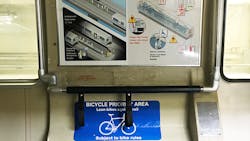Bay Area Rapid Transit introduces bike straps for all trains
Bicycle straps are coming to all Bay Area Rapid Transit trains after a successful pilot program tested variations of the straps.
Cyclists use the straps to secure the bikes to the rail, which stabilize the bikes and frees up the cyclists’ hands. Each strap secures two bikes.
The pilot program was led by BART Manager of Access Programs Steve Beroldo, who received feedback on the different strap types. He worked with a UC-Berkeley civil engineering student to prototype the straps.
“We wanted to offer a more formal method for people to hold their bikes,” Beroldo said, so they wouldn’t resort to makeshift solutions like bungee cords, and which would be safer and steadier for cyclists and non-cyclists alike.
What was ultimately chosen as the best design is a flame-retardant, nylon strap, similar to the overhead hand straps for holding on, with a simple, black buckle attached to the rail using a rivet for security.
An online survey gathered rider input on the straps and produced “overwhelmingly positive feedback,” Beroldo said. One rider wrote, “I love them! They are very helpful and I don't have to worry about my bike sliding and hitting others sitting nearby. Please install them everywhere!” Another commented on the increased room it provides, “I love, love, love them. Such a huge help and clears up space.”
The straps were originally tested in about 60 bike spaces on legacy cars throughout the BART system, with two straps per bike space. Now they’re being gradually added to all the original train cars.
And they’ll eventually be in new Fleet of the Future cars, too. The new cars were originally outfitted with built-in bike racks to test with riders but the design of three rubber U-shaped docks turned out not to be ideal for many cyclists. Bikes with larger tires didn’t fit easily in the racks, and although there were three spaces, sometimes only two bikes could fit.
“We listened to the feedback from bike riders, and they said the racks weren’t working well, so we’re going to take them out and go with the straps on all trains,” Beroldo said.
The hope for these new straps is to make bicyclists’ onboard experience easier, and thus encourage more people to ride their bikes to BART. This stems from the 2012 BART Bicycle Plan, which sets a goal of doubling the number of passengers who access BART by bicycle from the current 4 percent to 8 percent by 2022. An increase in this method of transport means less traffic congestion, increased ridership and a better BART experience for everyone.
